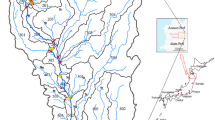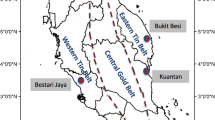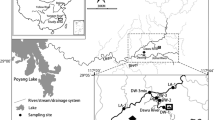Abstract
Constructing ponds to protect downstream ecosystems is a common practice in opencast coal mine reclamation. As these ponds remain integrated in the landscape, it is important to evaluate the extent of the effect of mine pollution on these ecosystems. However, this point has not been sufficiently addressed in the literature. The main objective of this work was to explore the metal pollution in man-made ponds constructed for runoff control in reclaimed opencast coal mines over time. To do so, we evaluated the concentration of ten heavy metals in the water, sediment, and Typha sp. in 16 runoff ponds ranging from 1 to 19 years old that were constructed in reclaimed opencast coal mines of northeastern Spain. To evaluate degree of mining pollution, we compared these data to those from a pit lake created in a local unreclaimed mine and to local streams as an unpolluted reference, as well as comparing toxicity levels in aquatic organisms. The runoff ponds showed toxic concentrations of Al, Cu, and Ni in the water and As and Ni in the sediment, which were maintained over time. Metal concentrations in runoff ponds were higher than in local streams, and macrophytes showed high metal concentrations. Nevertheless, metal concentrations in water and sediment in runoff ponds were lower than those in the pit lake. This study highlights the importance of mining reclamation to preserve the health of aquatic ecosystems and suggests the existence of chronic metal toxicity in the ponds, potentially jeopardizing pond ecological functions and services.




Similar content being viewed by others
References
APHA, AWWA, WPCF (1992) Métodos normalizados para el análisis de aguas potables y residuales. Ediciones Díaz de Santos.
Babcock, M. F., Evans, D. W., & Alberts, J. J. (1983). Comparative uptake and translocation of trace elements from coal ash by typha latifolia. The Science of the Total Environment, 28, 203–214.
Bernhardt, E. S., & Palmer, M. A. (2011). The environmental costs of mountaintop mining valley fill operations for aquatic ecosystems of the Central Appalachians. Annals of the New York Academy of Sciences, 1223, 39–57. doi:10.1111/j.1749-6632.2011.05986.x.
Blodau, C. (2006). A review of acidity generation and consumption in acidic coal mine lakes and their watersheds. The Science of the Total Environment, 369, 307–332. doi:10.1016/j.scitotenv.2006.05.004.
Braune, B., Muir, D., DeMarch, B., et al. (1999). Spatial and temporal trends of contaminants in Canadian Arctic freshwater and terrestrial ecosystems: a review. The Science of the Total Environment, 230, 145–207. doi:10.1016/S0048-9697(99)00038-8.
Brix, H., Dyhr-Jensen, K., & Lorenzen, B. (2002). Root-zone acidity and nitrogen source affects Typha latifolia L. growth and uptake kinetics of ammonium and nitrate. Journal of Experimental Botany, 53, 2441–2450. doi:10.1093/jxb/erf106.
Bungart, R., & Hüttl, R. (2001). Production of biomass for energy in post-mining landscapes and nutrient dynamics. Biomass and Bioenergy, 20, 181–187. doi:10.1016/S0961-9534(00)00078-7.
Casas, J. M., Rosas, H., Sole, M., & Lao, C. (2003). Heavy metals and metalloids in sediments from the Llobregat basin, Spain. Environmental Geology, 44, 325–332.
Clements, W. H. (1994). Benthic invertebrate community responses to heavy metals in the Upper Arkansas River Basin, Colorado. J North Am Benthol Soc, 13, 30–44. doi:10.2307/1467263.
Clements, W. H., Vieira, N. K. M., & Church, S. E. (2010). Quantifying restoration success and recovery in a metal-polluted stream: a 17-year assessment of physicochemical and biological responses. Journal of Applied Ecology, 47, 899–910. doi:10.1111/j.1365-2664.2010.01838.x.
Cravotta, C. (2008). Dissolved metals and associated constituents in abandoned coal-mine discharges, Pennsylvania, USA. Part 1: Constituent quantities and correlations. Applied Geochemistry, 23, 166–202. doi:10.1016/j.apgeochem.2007.10.011.
Croteau, M. N., Luoma, S. N., & Stewart, A. R. (2005). Trophic transfer of metals along freshwater food webs: evidence of cadmium biomagnification in nature. Limnology and Oceanography, 50, 1511–1519. doi:10.2307/3597695.
David, C. P. C. (2003). Establishing the impact of acid mine drainage through metal bioaccumulation and taxa richness of benthic insects in a tropical Asian stream (the Philippines). Environmental Toxicology and Chemistry, 22, 2952–2959. doi:10.1897/02-529.
Davidson, C. M., Thomas, R. P., McVey, S. E., et al. (1994). Evaluation of a sequential extraction procedure for the speciation of heavy metals in sediments. Analytica Chimica Acta, 291, 277–286.
Demirezen, D., & Aksoy, A. (2004). Accumulation of heavy metals in Typha angustifolia (L.) and Potamogeton pectinatus (L.) living in Sultan Marsh (Kayseri, Turkey). Chemosphere, 56, 685–696. doi:10.1016/j.chemosphere.2004.04.011.
Dorgelo, J., Meester, H., & van Velzen, C. (1995). Effects of diet and heavy metals on growth rate and fertility in the deposit-feeding snail Potamopyrgus jenkinsi (Smith) (Gastropoda: Hydrobiidae). Hydrobiologia, 316, 199–210. doi:10.1007/BF00017437.
Dubé, M. G., MacLatchy, D. L., Kieffer, J. D., et al. (2005). Effects of metal mining effluent on Atlantic salmon (Salmo salar) and slimy sculpin (Cottus cognatus): using artificial streams to assess existing effects and predict future consequences. The Science of the Total Environment, 343, 135–154. doi:10.1016/j.scitotenv.2004.09.037.
Dunbabin, J. S., & Bowmer, K. H. (1992). Potential use of constructed wetlands for treatment of industrial wastewaters containing metals. The Science of the Total Environment, 111, 151–168. doi:10.1016/0048-9697(92)90353-T.
Förstner, U., & Wittmann, G. T. W. (1983). Metal pollution in the aquatic environment. Netherlands: Springer.
Gambrell, R. (1994). Trace and toxic metals in wetlands—a review. Journal of Environmental Quality, 23, 883–891.
Gould, S. F. (2012). Comparison of post-mining rehabilitation with reference ecosystems in monsoonal eucalypt woodlands, northern Australia. Restoration Ecology, 20, 250–259. doi:10.1111/j.1526-100X.2010.00757.x.
Griffith, M. B., Norton, S. B., Alexander, L. C., et al. (2012). The effects of mountaintop mines and valley fills on the physicochemical quality of stream ecosystems in the central Appalachians: a review. The Science of the Total Environment, 417–418, 1–12. doi:10.1016/j.scitotenv.2011.12.042.
Hart, T. M., & Davis, S. E. (2011). Wetland development in a previously mined landscape of East Texas, USA. Wetlands Ecology and Management, 19, 317–329. doi:10.1007/s11273-011-9218-2.
Hartman, K. J., Kaller, M. D., Howell, J. W., & Sweka, J. A. (2005). How much do valley fills influence headwater streams? Hydrobiologia, 532, 91–102. doi:10.1007/s10750-004-9019-1.
Hobbs, R. J., & Norton, D. A. (1996). Towards a conceptual framework for restoration ecology. Restoration Ecology, 4, 93–110. doi:10.1111/j.1526-100X.1996.tb00112.x.
Hollander, M., & Wolfe, D. A. (1973). Nonparametric statistical methods. New York: John Wiley & Sons.
Hopkins, R. L., Altier, B. M., Haselman, D., et al. (2013). Exploring the legacy effects of surface coal mining on stream chemistry. Hydrobiologia, 713, 87–95. doi:10.1007/s10750-013-1494-9.
Johnson, D. B. (2003). Chemical and microbiological characteristics of mineral spoils and drainage waters at abandoned coal and metal mines. Water Air Soil Pollut Focus, 3, 47–66.
Lindberg, T. T., Bernhardt, E. S., Bier, R., et al. (2011). Cumulative impacts of mountaintop mining on an Appalachian watershed. Proceedings of the National Academy of Sciences, 108, 20929–20934. doi:10.1073/pnas.1112381108.
Loayza-Muro, R. A., Elías-Letts, R., Marticorena-Ruíz, J. K., et al. (2010). Metal-induced shifts in benthic macroinvertebrate community composition in Andean high altitude streams. Environmental Toxicology and Chemistry, 29, 2761–2768. doi:10.1002/etc.327.
MacDonald, D. D., Ingersoll, C. G., & Berger, T. A. (2000). Development and evaluation of consensus-based sediment quality guidelines for freshwater ecosystems. Archives of Environmental Contamination and Toxicology, 39, 20–31.
Majer, & Nichols. (1998). Long-term recolonization patterns of ants in Western Australian rehabilitated bauxite mines with reference to their use as indicators of restoration success. Journal of Applied Ecology, 35, 161–182. doi:10.1046/j.1365-2664.1998.00286.x.
Markert, B. (1992). Presence and significance of naturally-occurring chemical-elements of the periodic system in the plant organism and consequences for future investigations on inorganic environmental chemistry in ecosystems. Vegetatio, 103, 1–30.
McNaughton, S. J., Folsom, T. C., Lee, T., et al. (1974). Heavy metal tolerance in Typha latifolia without the evolution of tolerant races. Ecology, 55, 1163–1165.
Meeravali, N. N., & Kumar, S. J. (2000). Comparison of open microwave digestion and digestion by conventional heating for the determination of Cd, Cr, Cu and Pb in algae using transverse heated electrothermal atomic absorption spectrometry. Fresenius' Journal of Analytical Chemistry, 366, 313–315. doi:10.1007/s002160050061.
Merricks, T. C., Cherry, D. S., Zipper, C. E., et al. (2007). Coal-mine hollow fill and settling pond influences on headwater streams in southern West Virginia, USA. Environmental Monitoring and Assessment, 129, 359–378.
Meyer, C. K., Baer, S. G., & Whiles, M. R. (2008). Ecosystem recovery across a chronosequence of restored wetlands in the Platte River Valley. Ecosystems, 11, 193–208. doi:10.1007/s10021-007-9115-y.
Miguel-Chinchilla L (2013) Physicochemical and macroinvertebrate community trends in manmade ponds constructed in reclaimed opencast coal mines. Universidad de Alcalá.
Miguel-Chinchilla L, Boix D, Gascón S, Comín FA (2014) Macroinvertebrate biodiversity patterns during primary succession in manmade ponds in north-eastern Spain. J. Limnol. 73
Mitsch, W. J., & Gosselink, J. G. (2000). Wetlands (3rd ed.). New York: Wiley.
Mitsch, W. J., & Wise, K. M. (1998). Water quality, fate of metals, and predictive model validation of a constructed wetland treating acid mine drainage. Water Research, 32, 1888–1900. doi:10.1016/S0043-1354(97)00401-6.
Nadkarni, R. A. (1984). Applications of microwave oven sample dissolution in analysis. Analytical Chemistry, 56, 2233–2237. doi:10.1021/ac00276a056.
Nicolau, J. M. (2003). Trends in relief design and construction in opencast mining reclamation. Land Degradation and Development, 14, 215–226.
Palmer, M., Bernhardt, E., Schlesinger, W., et al. (2010). Mountaintop mining consequences. Science, 327, 148–149. doi:10.1126/science.1180543.
Parker, G. H. (2004). Tissue metal levels in Muskrat (Ondatra zibethica) collected near the Sudbury (Ontario) ore-smelters; prospects for biomonitoring marsh pollution. Environmental Pollution, 129, 23–30. doi:10.1016/j.envpol.2003.10.003.
Pinheiro J, Bates D, DebRoy S, et al. (2012) nlme: linear and nonlinear mixed effects models. R Package Version 31-111
Pond, G. J., Passmore, M. E., Borsuk, F. A., et al. (2008). Downstream effects of mountaintop coal mining: comparing biological conditions using family- and genus-level macroinvertebrate bioassessment tools. J North Am Benthol Soc, 27, 717–737. doi:10.1899/08-015.1.
Pueyo, M., Rauret, G., Luck, D., et al. (2001). Certification of the extractable contents of Cd, Cr, Cu, Ni, Pb and Zn in a freshwater sediment following a collaboratively tested and optimised three-step sequential extraction procedure. Journal of Environmental Monitoring, 3, 243–250.
R Core Team. (2012). R: a language and environment for statistical computing. Vienna: R foundation for Statistical Computing. R Foundation for Statistical Computing.
Rauret, G. (1998). Extraction procedures for the determination of heavy metals in contaminated soil and sediment. Talanta, 46, 449–455.
Rodrigue, J. A., Burger, J. A., & Oderwald, R. G. (2002). Forest productivity and commercial value of pre-law reclaimed mined land in the eastern United States. Northern Journal of Applied Forestry, 19, 106–114.
Samecka-Cymerman, A., & Kempers, A. J. (2001). Concentrations of heavy metals and plant nutrients in water, sediments and aquatic macrophytes of anthropogenic lakes (former open cut brown coal mines) differing in stage of acidification. The Science of the Total Environment, 281, 87–98.
Sasmaz, A., Obek, E., & Hasar, H. (2008). The accumulation of heavy metals in Typha latifolia L. grown in a stream carrying secondary effluent. Ecological Engineering, 33, 278–284.
Sastre, J., Sahuquillo, A., Vidal, M., & Rauret, G. (2002). Determination of Cd, Cu, Pb and Zn in environmental samples: microwave-assisted total digestion versus aqua regia and nitric acid extraction. Analytica Chimica Acta, 462, 59–72. doi:10.1016/S0003-2670(02)00307-0.
Sawtsky L, McKenna G, Keys MJ, Long D (2000) Towards minimising the long-term liability of reclaimed mine sites. In: Haigh MJ (ed) Reclaimed Land Eros. Control Soils Ecol. Taylor & Francis, pp 21–36.
Sheoran, A. S., & Sheoran, V. (2006). Heavy metal removal mechanism of acid mine drainage in wetlands: a critical review. Minerals Engineering, 19, 105–116. doi:10.1016/j.mineng.2005.08.006.
Shrestha, R. K., & Lal, R. (2006). Ecosystem carbon budgeting and soil carbon sequestration in reclaimed mine soil. Environment International, 32, 781–796.
Smith, F. E., & Arsenault, E. A. (1996). Microwave-assisted sample preparation in analytical chemistry. Talanta, 43, 1207–1268. doi:10.1016/0039-9140(96)01882-6.
US EPA. (2002). National Recommended Water Quality Criteria: 2002. Office of Water, EPA-822-R-02-047. Washinton, DC: United States Environmental Protection Agency. Accessed 23 Jun 2013.
Vickers, H., Gillespie, M., & Gravina, A. (2012). Assessing the development of rehabilitated grasslands on post-mined landforms in north west Queensland, Australia. Agriculture, Ecosystems and Environment, 163, 72–84. doi:10.1016/j.agee.2012.05.024.
Walker, L. R., Wardle, D. A., Bardgett, R. D., & Clarkson, B. D. (2010). The use of chronosequences in studies of ecological succession and soil development. Journal of Ecology, 98, 725–736. doi:10.1111/j.1365-2745.2010.01664.x.
Wei, X., Wei, H., & Viadero, R. C., Jr. (2011). Post-reclamation water quality trend in a Mid-Appalachian watershed of abandoned mine lands. The Science of the Total Environment, 409, 941–948. doi:10.1016/j.scitotenv.2010.11.030.
Weis, J. S., & Weis, P. (2004). Metal uptake, transport and release by wetland plants: implications for phytoremediation and restoration. Environment International, 30, 685–700.
Witeska, M., Sarnowski, P., Ługowska, K., & Kowal, E. (2013). The effects of cadmium and copper on embryonic and larval development of ide Leuciscus idus L. Fish Physiol Biochem Adv Online Publ. doi:10.1007/s10695-013-9832-4.
Wong, M. (2003). Ecological restoration of mine degraded soils, with emphasis on metal contaminated soils. Chemosphere, 50, 775–780. doi:10.1016/S0045-6535(02)00232-1.
Ye, Z. H., Lin, Z. Q., Whiting, S. N., et al. (2003). Possible use of constructed wetland to remove selenocyanate, arsenic, and boron from electric utility wastewater. Chemosphere, 52, 1571–1579. doi:10.1016/S0045-6535(03)00497-1.
Younger, P. L. (2001). Mine water pollution in Scotland: nature, extent and preventative strategies. The Science of the Total Environment, 265, 309–326. doi:10.1016/S0048-9697(00)00673-2.
Yucel, D. S., & Baba, A. (2012). Geochemical characterization of acid mine lakes in northwest Turkey and their effect on the environment. Archives of Environmental Contamination and Toxicology, 64, 357–376. doi:10.1007/s00244-012-9843-7.
Acknowledgments
This work was supported by a research and assistance agreement between Endesa Foundation and the Pyrenean Institute of Ecology-CSIC. The regional government of Aragón, Spain supported the PhD studies of the first author. We are grateful to our fieldwork assistants as well as the Endesa S.A. and their employees in the Teruel mines. Finally, we would like to thank the anonymous reviewers for their helpful comments on a previous version of this manuscript.
Author information
Authors and Affiliations
Corresponding author
Rights and permissions
About this article
Cite this article
Miguel-Chinchilla, L., González, E. & Comín, F.A. Assessing metal pollution in ponds constructed for controlling runoff from reclaimed coal mines. Environ Monit Assess 186, 5247–5259 (2014). https://doi.org/10.1007/s10661-014-3774-x
Received:
Accepted:
Published:
Issue Date:
DOI: https://doi.org/10.1007/s10661-014-3774-x




